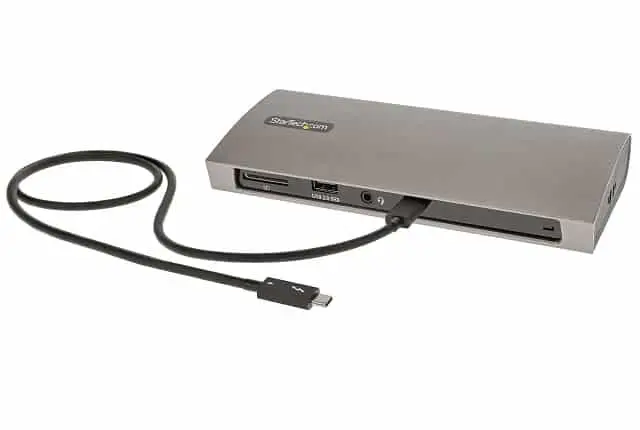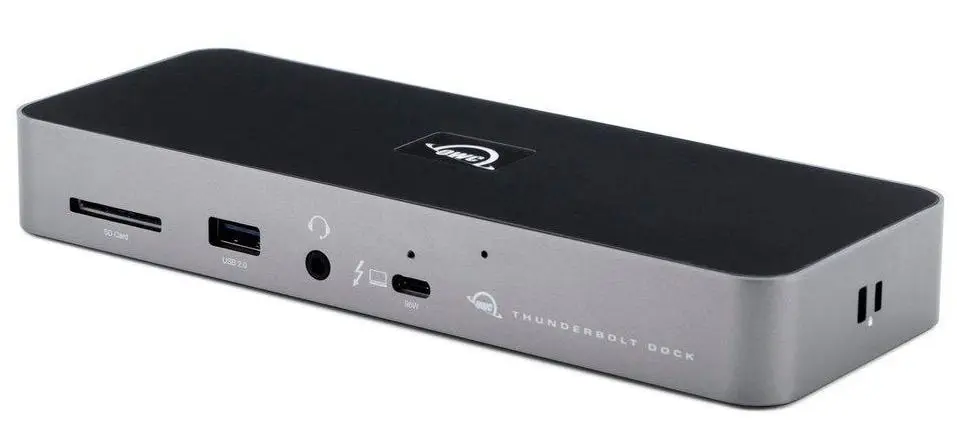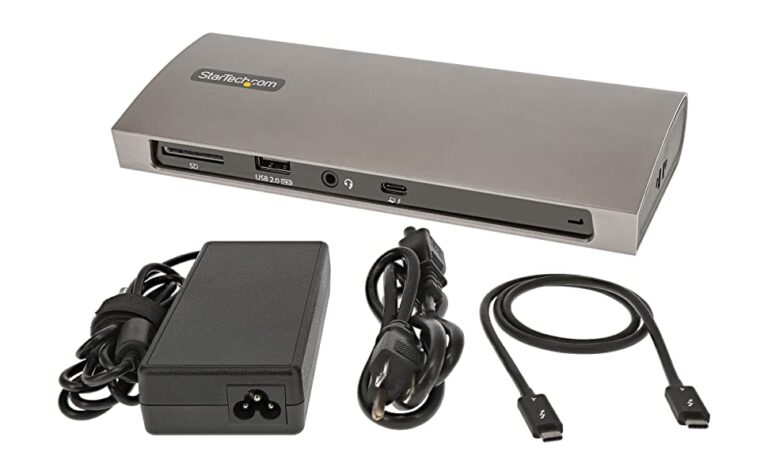StarTech is a Canadian company having distribution centres in the US, Canada, the UK, and Hong Kong. It provides a massive selection of cables, equipment, and peripherals that are popular among IT professionals and tech-savvy hobbyists alike. StarTech already supported Thunderbolt technology, so adopting the new Thunderbolt 4 standard wasn’t a clear choice.
What distinguishes the StarTech Thunderbolt 4 Dock from competitors such as Caldigit, OWC, Plugable, and Glyph?
What will you see here?
Price and Availability of StarTech Thunderbolt 4

In a nutshell, ‘ouch.’ The StarTech Thunderbolt 4 Dock costs $439.99 to US consumers at the time of writing.
The Thunderbolt 4 Dock is available on the StarTech website in the United States and Canada. However, it’s not there on the product sites in Europe or Asia at this time.
The price appears to show how this company previously positioned these items. The StarTech Thunderbolt 3 Dock, which provides the same capability, costs $389.99.
To put the expensive cost of this gear into perspective, the nearest competing option is the OWC Thunderbolt Dock. OWC costs $279, or 64% less than the StarTech pricing.
Design of StarTech Thunderbolt 4
Over the last year, we’ve seen several uninspiring Thunderbolt dock and hub layouts that are little more than aluminium tubes.
Fortunately, StarTech’s engineers have a little more flair, and its design appears to be coming from an aeroplane wing. Although its aerodynamic design doesn’t affect the technology which is within the port. However, it definitely looks nicer than some docks on the market.
When put on the desktop for usage, the thin trailing edge faces the user and the broader leading edge faces away, which is a little unusual twist on the wing aesthetics. This approach makes sense because the majority of ports are on the device’s back, and the sheer quantity of connectors surpasses the space available on the device’s narrower front face.
The most notable difference in this design is that StarTech made no attempt to provide any openings or other means of ventilating the internal electronics. Instead, it appears that this design is totally reliant on the thick aluminium metal of the shell to dissipate heat to the outside.
Ports of StarTech Thunderbolt 4

A full-sized SD card port, a single USB 2.0 Type-A port, a 3.5mm sound connector, and a single Type-C Thunderbolt link from a computer connected are all available on the front face.
The power receptacle is located on the rear, along with three USB 3.2 Gen 2 (10Gbps) Type-A connections, three Type-C Thunderbolt 3 connectors, and one 1Gbit Ethernet LAN port.
There are no HDMI or DisplayPort outputs. However, the User can convert any of the three Thunderbolt ports into monitor connections using adapters made by StarTech. There are two security slits on the right side, and there are no details on the left side.
The hardware of StarTech Thunderbolt 4

At the heart of all Thunderbolt 4 hubs and docks are now available in the same Intel-created technology. These chips provide hardware manufacturers with a slew of options for what functionality they want to enable via USB, Thunderbolt, and other connection methods.
StarTech’s strategy is to provide the greatest level of flexibility for the client, recognizing that these devices are frequently reused over their working career.
Charging
The Thunderbolt 4 link to the host machine enables up to 96W charging, which is the highest amount of power on a Thunderbolt dock so far.
That makes it excellent for mobile workstations that require 90W+ to run and charge, particularly those that aren’t sufficiently supported by docks that only offer 60W or even 85W.
The Liteon PSU has a power output of 135W. That capacity must include not just the 96W that can be transferred to the attached laptop, but also the 15W required by each downstream Thunderbolt port. Also, the 7.5W that the USB 2.0 port may relay for recharging a phone or tablet, and whatever juice the dock requires to run.
It’s worth noting that, depending on the number of devices connected, there may be a tiny power oversubscription here, and we’d anticipate that the laptop would get somewhat less power, in that case, to prevent drawing more power from the PSU than it is rated for.
Data Transfers
Similarly, combining the bandwidth of the three Thunderbolt 3 downstream ports plus the USB 3.2 Gen 2 ports would surpass the total 40Gbits that Thunderbolt 4 must allocate by at least 50%.
This deficit is especially likely if any downstream ports are utilized for displays because the bandwidth sacrificed for them cannot be easily surrendered for other data-transferring peripherals.
This is a restriction of Thunderbolt 4 technology in general, not of this dock particularly. Intel forces hardware manufacturers to produce docks and hubs with more ports that support full performance. They naively anticipate that fewer users will ever encounter these practical restrictions, and to some extent, they are probably correct.
How to use it?
Thunderbolt technology means to be plug-and-play, setting up the StarTech Thunderbolt 4 dock is as simple as you might imagine.
Once it connects to the computer and the Thunderbolt control center approves it, the peripherals or services will show on the host system.
StarTech goes above and beyond by providing a bespoke connectivity tool that allows administrators to view devices’ connection to the host PC directly and via the dock.
It has other purposes besides functioning with the dock. However, installing this utility allows the host PC’s MAC address to transmit through to the dock LAN adapter, which is ideal for sites that utilize MAC address filtering.
If you wish to utilize a monitor with this dock, StarTech sells several at a higher price than you can find this technology elsewhere.
For an eye-watering $142.99, it offers a dual DisplayPort 1.4 adaptor (TB32DP14) that enables two 4K panels or a single 8K/5K panel. StarTech has a $99 model that only functions with Windows PCs, but the layout for both PC and Mac is significantly more expensive.
Competitors

There are a plethora of Thunderbolt 4 designs available now that include the majority of the capabilities displayed above. Most of them are less expensive than this one.
The OWC Thunderbolt Dock is a great alternative. It has almost as much recharging power as the StarTech design, at 90W, and a nearly comparable connector arrangement. But, most importantly, it costs only $279, significant savings above StarTech’s $439.99 asking price.
Conclusion
What is apparent is that StarTech has created a highly sophisticated and stylish Thunderbolt 4 dock with several applications. The amount of charge power it can provide, also the versatility provided by this many ports, are critical.
In comparison, the unit price makes other excellent Thunderbolt 4 docks appear like a steal. It’s far too pricey, especially since display adapters are also there in the purchase price. It would have been easy to recommend if StarTech had priced it more appropriately. As things stand, alternative Thunderbolt 4 solutions make more financial sense.
Read More:
- Best MacBook Pro Docking Station for faster connections!
- Connect Multiple Things with the Best Docking Station!
- Best HDMI Splitters you can get right now!
- How to use the Dock on your Mac?
- Best Monitors for Mac of 2022 to enhance your Mac using experience!
















